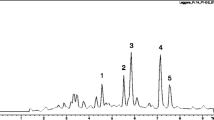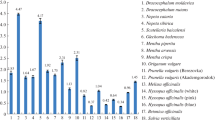Abstract
During the screening of anti-influenza virus substances from traditional herbal medicines, the methanol extract from the leaves of Pogostemon cablin Benth. showed potent in vitro antiviral activity (99.8% inhibition at a concentration of 10 μg/mL) against influenza virus A/PR/8/34 (H1N1). The anti-influenza virus principle was isolated from the hexane-soluble fraction, through solvent fractionation, repeated silica gel column chromatography, and reversed-phase HPLC. The major active principle was a volatile substance that was identified as a sesquiterpene, patchouli alcohol (1), on the basis of its spectral analyses. When anti-influenza virus activity against A/PR/8/34 was evaluated by the plaque forming assay, patchouli alcohol reduced the number of plaques by 75% at 2 μg/mL and 89% at 10 μg/mL. Patchouli alcohol showed dose-dependent anti-influenza virus activity, and its IC50 value was estimated to be 2.635 μM. Although 11 different sesquiterpenes were tested for antiviral activity against influenza virus A/PR/8/34, no or negligible activity was observed except for patchouli alcohol. Patchouli alcohol did not show anti-influenza virus activity against A/Guizhou/54/89 (H3N2), but showed weak activity against B/Ibaraki/2/85 (IC50 = 40.82 μM). Patchouli alcohol did not show inhibitory activity against influenza virus neuraminidase.



Similar content being viewed by others
References
Long JK, Mossak SB, Goldman MP (1999) Antiviral agents for treating influenza. Cleve Clin J Med 67:92–95
Hirsch MS, Kaplan JC (1990) Antiviral agents. In: Fields BN, Knipe DM (eds) Virology. Raven, New York, pp 441–468
Stephenson I, Nicholson KG (1999) Chemotherapeutic control of influenza. J Antimicrob Chemother 44:6–10
Ge H, Wang YF, Xu J, Gu Q, Liu HB, Xiao PG, Zhou J, Liu Y, Yang Z, Su H (2010) Anti-influenza agents from traditional Chinese medicine. Nat Prod Rep 27:1758–1780
Pappaioanou M (2009) Highly pathogenic H5N1 avian influenza virus: cause of the next pandemic? Comp Immunol Microbiol Infect Dis 32:287–300
Girard MP, Tam JS, Assossou OM, Kieny MP (2010) The 2009 A (H1N1) influenza virus pandemic: a review. Vaccine 28:4895–4902
Boltz DA, Aldridge JR Jr, Webster RG, Govorkova EA (2010) Drugs in development for influenza. Drugs 70:1349–1362
Kawamura Y, Kiyohara H, Nagai T, Hiramoto T, Yamada H (2010) Anti-influenza virus active sesquiterpene from leaves of Pogostemon cablin. Abstr Annu Meet Pharm Soc Jpn 130(2):179
Xie YC, Tang F (2009) Protective effect of Pogostemon cablin on membrane fluidity of intestinal epithelia cell in ischemia/reperfusion rats after ischemia/reperfusion. Zhongguo Zhong Xi Yi Jie He Za Zhi 29:639–641
Kim HW, Cho SJ, Kim BY, Cho SI, Kim YK (2010) Pogostemon cablin as ROS scavenger in oxidant-induced cell death of human neuroglioma cells. Evid Based Complement Alternat Med 7:239–247. doi:10.1093/ecam/nem176
Tsai YC, Hsu HC, Yang WC, Tsai WJ, Chen CC, Watanabe T (2007) α-Bulnesene, a PAF inhibitor isolated from the essential oil of Pogostemon cablin. Fitoterapia 78:7–11
Yang Y, Kinoshita K, Koyama K, Takahashi K, Tai T, Nunoura Y, Watanabe K (1999) Anti-emetic principles of Pogostemon cablin (Blanco) Benth. Phytomedicine 6:89–93
Lai X, Su Z, Zhang F, Peng S, Hu J (2010) Use of patchouli alcohol in medicament preparation. PCT WO2010/096987
Shimizu T, Hino A, Tsutsumi A, Park YK, Watanabe W, Kurokawa M (2008) Anti-influenza virus activity of propolis in vitro and its efficacy against influenza infection in mice. Antivir Chem Chemother 19:7–13
Neszmelyi A, Lukacs G (1981) Natural abundance 13C–13C coupling constants for carbon connectivity pattern determination and NMR spectra analysis: patchoulol. J Chem Soc Chem Commun 999–1001
Dobler M, Dunitz JD, Gubler B, Weber HP (1963) The structure of patchouli alcohol. Proc Chem Soc London 383
Roberts JS (1972) The sesquiterpenoids. In: Newman AA (ed) Chemistry of terpenes and terpenoids. Academic, London, pp 88–146
Wei G (2007) Digitalization of gas chromatography-mass spectrometry characteristic fingerprint chromatogram of Pogostemon cablin and its application in herb identification. Zhongchengyao 29:322–325
Cai QQ, Huang YH, Xi P, Zen HF, Tang HM (2006) Analysis of Huoxiangzhengqifang extracted by supercritical carbon dioxide with TLC and gas chromatography-mass spectrometry. Xiandai Shipin Yu Yaopin Zazhi 16:32–34
Minagawa K, Kouzuki S, Yoshimoto J, Kawamura Y, Tani H, Iwata T, Terui Y, Nakai H, Yagi S, Hattori N, Fujiwara T, Kamigauchi T (2002) Stachyflin and acetylstachyflin, novel anti-influenza A virus substances, produced by Stachybotrys sp. RF-7260. J Antibiotics 55:155–164
Wright AE, Rueth SA, Cross SS (1991) An antiviral sesquiterpene hydroquinone from the marine sponge Strongylophora hartmani. J Nat Prod 54:1108–1111
Yoshimoto J, Kakui M, Iwasaki H, Fujiwara T, Sugimoto H, Hattori N (1999) Identification of a novel HA conformational change inhibitor of human influenza virus. Arch Virol 144:865–878
Nagai T, Nishibe Y, Makino Y, Tomimori T, Yamada H (1997) Enhancement of in vivo anti-influenza virus activity of 5,7,4′-trihydroxy-8-methoxyflavone by drug delivery system using hydroxypropyl cellulose. Biol Pharm Bull 20:1082–1085
Watanabe W, Konno K, Ijichi K, Inoue H, Yokota T, Shigeta S (1994) MTT colorimetric assay system for the screening of anti-orthomyxo- and anti-paramyxoviral agents. J Virol Methods 48:257–265
Miki K, Nagai T, Suzuki K, Tsujimura R, Koyama K, Kinoshita K, Furuhata K, Yamada H, Takahashi K (2007) Anti-influenza virus activity of biflavonoids. Bioorg Med Chem Lett 17:772–775
Acknowledgments
The authors thank the Takasago International Corporation (Tokyo, Japan) for kind gifts of standard sesquiterpenes. A part of the present work was supported by The 21st Century COE Program, Ministry of Education, Culture, Sports, Science and Technology of Japan.
Author information
Authors and Affiliations
Corresponding authors
Rights and permissions
About this article
Cite this article
Kiyohara, H., Ichino, C., Kawamura, Y. et al. Patchouli alcohol: in vitro direct anti-influenza virus sesquiterpene in Pogostemon cablin Benth.. J Nat Med 66, 55–61 (2012). https://doi.org/10.1007/s11418-011-0550-x
Received:
Accepted:
Published:
Issue Date:
DOI: https://doi.org/10.1007/s11418-011-0550-x




